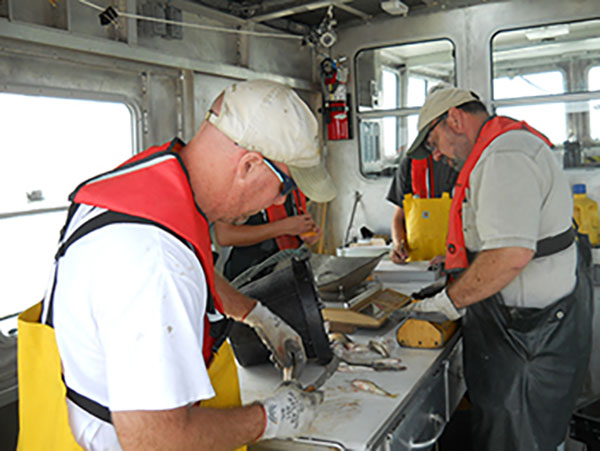MDNR Report
 DNR Biologists
DNR Biologists
Based on the 24 trawl tows and 16 gillnet lifts conducted in September by the Department’s R/V Tanner and Channel Cat, initial findings indicate few changes to the Saginaw Bay fishery.
Overall, a total of 24 different species were collected by trawling and 27 different species were collected by gillnetting, with no new species collected.
Walleye abundance appears strong, and there are large year classes being documented from 2021 and 2022. Observations of a strong 2021-year class were supported by a large catch of juvenile walleye ranging in size from 10 to 12 inches. The evidence supporting the predicted strong 2019-year class will have to wait until all specimens can be aged in the laboratory this winter. Overall, the mean catch of larger walleye in gillnets (36.6/net) was slightly higher than the average (33.8/net) since 2003. The mean catch of young-of-year walleye in trawls was the highest since 2009, and second highest ever, indicating young walleye production remains very high.
Yellow perch appear to continue to be very depressed in numbers and may be nearing record lows. The catch of larger yellow perch in gillnets remains low (33.5/net), and much less than the average since 2003 (45.3/net). The production of young yellow perch was also noted to be very low, and the trawl numbers were the lowest since 2014. Research also indicated that the survival of yellow perch in their first year of life was low.
Preliminary forage fish numbers appeared to have declined for the second straight year, too, and were below the long-term mean but slightly above the last 10-year mean. The most common forage fish in the trawling by number were trout-perch, sand shiner, white perch, round goby and young age-0 yellow perch.
While the DNR has been working cooperatively with partners including the U.S. Fish and Wildlife Service and U.S. Geological Survey to restore native cisco to the Saginaw Bay area, no cisco were collected during the survey. A juvenile lake sturgeon, another species with active rehabilitation efforts, was collected in a gillnet and then tagged and released.
“Overall, walleye continue to dominate Saginaw Bay and its fish community, while efforts to improve yellow perch continue to struggle with that component of the fishery and forage fish numbers are generally stable,” said David Fielder, Alpena Fisheries Research Station, research biologist. “We expect the Saginaw Bay fishery will continue to look similar to 2022 for the next few years.”